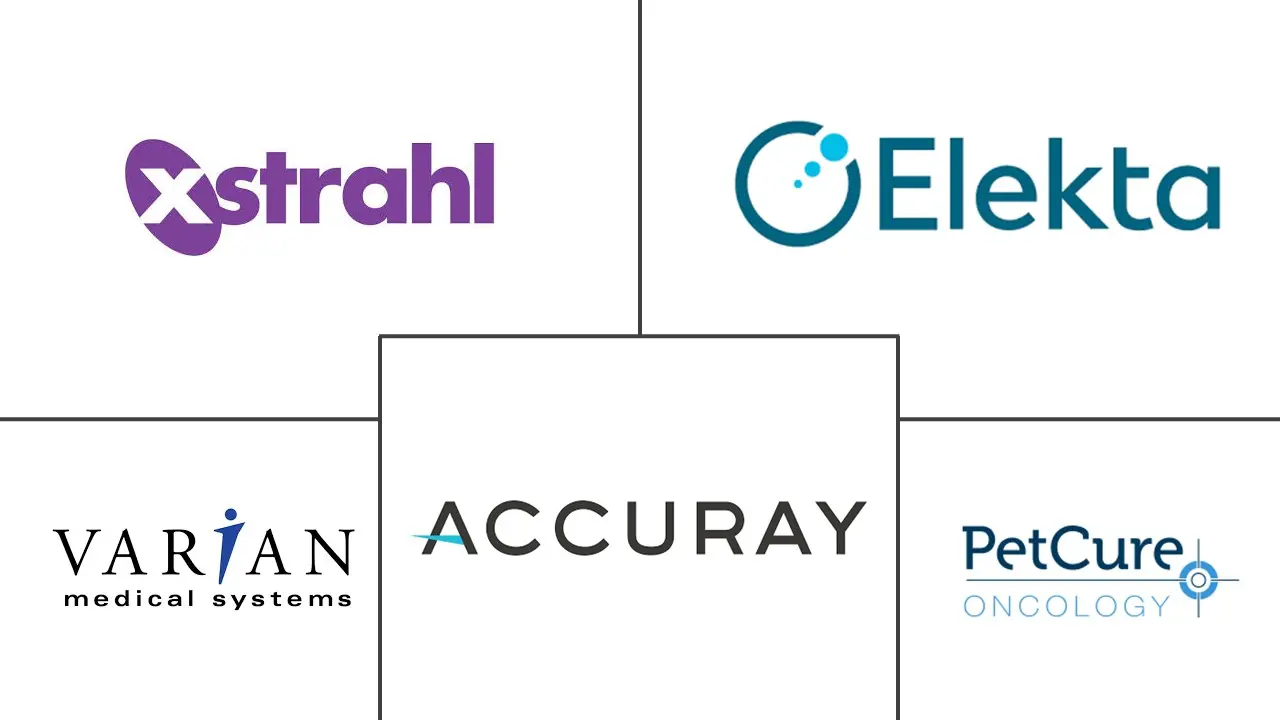Veterinary Stereotactic Radiosurgery Systems Market Size and Share
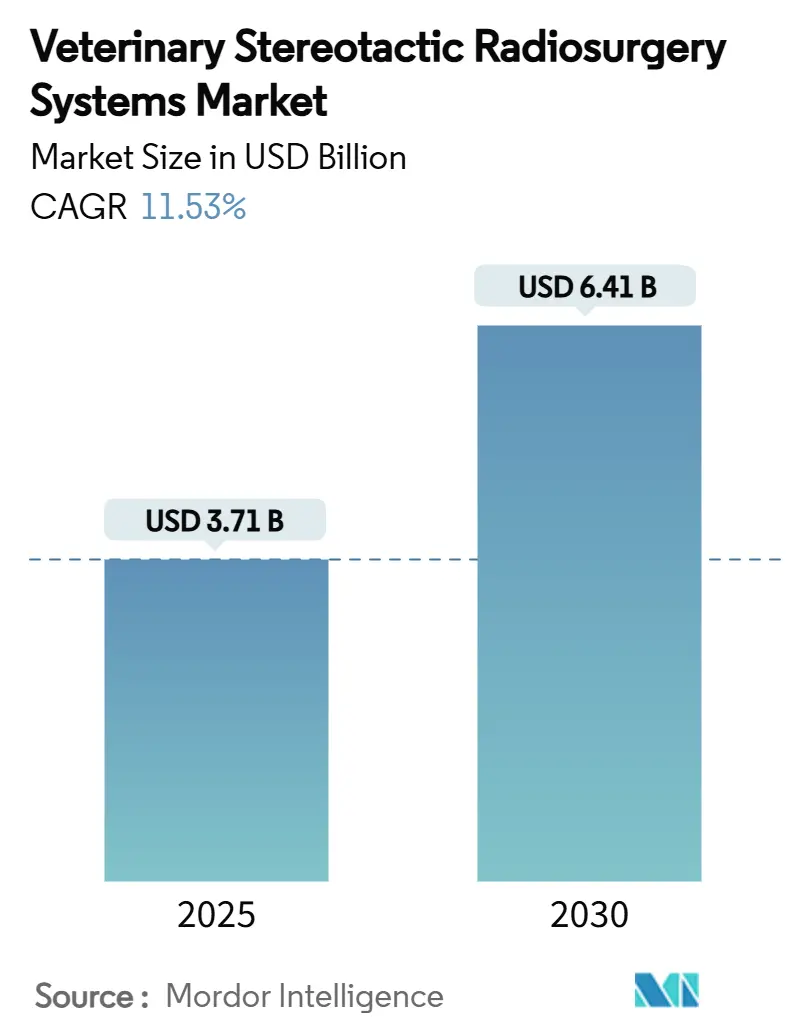
Veterinary Stereotactic Radiosurgery Systems Market Analysis by Mordor Intelligence
The veterinary stereotactic radiosurgery systems market size was USD 3.71 billion in 2025 and is forecast to reach USD 6.41 billion by 2030, reflecting an 11.53% CAGR through the period. Demand rises as companion-animal owners seek the same precision oncology options available in human medicine, while growing corporate ownership of referral hospitals improves capital access for high-cost radiation platforms. Linear accelerators remain the workhorse modality, yet proton and heavy-ion solutions gain traction as facilities look to differentiate with superior dose conformity. Rising pet-insurance reimbursement for high-cost care lowers economic barriers to treatment, and ongoing convergence of imaging and therapy platforms reduces procedure time, enhancing throughput. Supply-side bottlenecks persist because fewer than 100 board-certified veterinary radiation oncologists worldwide can operate these systems, constraining near-term capacity expansion.
Key Report Takeaways
- By product, linear accelerators led with 48.54% revenue share in 2024, while proton and heavy-ion platforms are projected to expand at 13.56% CAGR to 2030.
- By application, brain-tumor cases accounted for 41.45% of the Veterinary stereotactic radiosurgery systems market share in 2024 and head-and-neck treatments are advancing at a 13.54% CAGR through 2030.
- By end user, hospitals held 52.56% of the Veterinary stereotactic radiosurgery systems market size in 2024 and research institutions post the fastest growth at 13.78% CAGR to 2030.
- By animal type, companion-animal cases captured 58.65% share in 2024; equine indications are projected to rise at a 12.99% CAGR between 2025 and 2030.
- Photon delivery retained 45.67% share in 2024, while proton and heavy-ion beams are gaining at 12.43% CAGR through 2030.
- By geography, North America led with 38.76% share in 2024; the Asia–Pacific region is expanding at 12.56% CAGR through 2030.
Global Veterinary Stereotactic Radiosurgery Systems Market Trends and Insights
Driver Impact Analysis
| Driver | % Impact on CAGR Forecast | Geographic Relevance | Impact Timeline |
|---|---|---|---|
| Growing companion animal oncology caseload | +3.2% | Global (strongest in North America & Europe) | Long term (≥4 years) |
| Expansion of veterinary specialty referral networks | +2.8% | North America & EU core; spill-over to APAC | Medium term (2-4 years) |
| Technological convergence of imaging and radiotherapy platforms | +2.1% | Global, led by developed markets | Medium term (2-4 years) |
| Increasing availability of pet insurance for high-cost procedures | +1.9% | North America & EU; emerging in APAC | Long term (≥4 years) |
| Emerging demand for precision oncology in equine and exotic species | +1.3% | Global, early uptake in performance-horse markets | Long term (≥4 years) |
| Source: Mordor Intelligence | |||
Growing Companion-Animal Oncology Caseload
One in four dogs develops cancer during its lifetime, making malignancy the principal cause of death in senior pets. Early-detection tools such as IDEXX’s USD 15 Cancer Dx blood test broaden the pool of treatable cases by identifying lymphoma before clinical signs appear. Precision radiosurgery offers sub-millimeter dose targeting that spares healthy tissue, allowing treatment of brain and spinal tumors previously deemed inoperable. Higher caseloads create network effects: as hospitals perform more procedures, outcomes improve and referral confidence rises. This volume-driven model underpins the investment rationale for multi-million-dollar platforms, reinforcing upward demand for equipment and skilled staff.
Expansion of Veterinary Specialty Referral Networks
Corporate groups such as Mars Petcare operate around 3,000 clinics worldwide, many of which funnel complex oncology cases into flagship centers equipped with stereotactic systems. Consolidation aggregates caseloads, improving asset utilization and financing terms for capital purchases. Real-estate investment funds focused on veterinary specialty developments indicate growing outside investor interest, further accelerating infrastructure build-out. Expanded networks shorten client travel distance, reducing a historical barrier to advanced care adoption, and create regional training hubs that enhance workforce capability.
Technological Convergence of Imaging and Therapy
Elekta’s AI-driven Evo linear accelerator integrates high-definition imaging, enabling real-time adaptive planning that compensates for intra-fraction motion. Varian’s HyperSight option halves cone-beam CT acquisition time, addressing anesthesia-duration constraints in veterinary practice. RefleXion’s biology-guided X1 platform links PET imaging and therapy in a single gantry, tracking tumors based on metabolic signals rather than external markers. These innovations cut setup time, streamline workflows, and widen the addressable clinic base by lowering operational complexity. As platforms co-evolve, software upgrades extend hardware life cycles, supporting steady revenue streams for manufacturers and enabling mid-sized hospitals to enter the market.
Increasing Availability of Pet Insurance for High-Cost Procedures
Products from carriers such as Fetch and Healthy Paws reimburse up to 90% of radiation-oncology invoices, removing a key affordability barrier. Average course-of-care costs between USD 3,000 and USD 12,000 move within reach for a growing insured population. Insurers recognize that curative stereotactic regimens can reduce long-term palliative expenses, creating pricing alignment between payers and providers. Predictable reimbursement promotes bank financing of equipment purchases, supporting further diffusion across private referral centers.
Restraints Impact Analysis
| Restraints Impact Analysis | (~) % Impact on CAGR Forecast | Geographic Relevance | Impact Timeline |
|---|---|---|---|
| High capital expenditure and operating costs | -2.7% | Global; most acute in emerging markets | Short term (≤2 years) |
| Limited supply of board-certified veterinary radiation oncologists | -2.1% | Global; most severe in APAC & emerging regions | Long term (≥4 years) |
| Uncertain long-term radiobiological outcomes across species | -1.4% | Global | Long term (≥4 years) |
| Limited reimbursement coverage in emerging markets | -1.2% | APAC, Latin America, Middle East & Africa | Medium term (2-4 years) |
| Source: Mordor Intelligence | |||
High Capital Expenditure and Operating Costs
A single linear accelerator requires USD 2–4 million in upfront hardware outlay, plus shielding-room construction that can add USD 1–2 million. Annual service contracts typically equal 3.1% of original cost, while mandatory quality-assurance programs add staffing and dosimetry expenses. In low-volume regions, payer mix and caseload rarely deliver breakeven throughput, curbing new-unit placements. Smaller practices increasingly seek joint-venture or corporate ownership structures to share capital risk, which accelerates consolidation but restricts entry for independent clinics.
Limited Supply of Board-Certified Veterinary Radiation Oncologists
Fewer than 100 specialists are currently credentialed worldwide, with most concentrated in North America and Western Europe. Residency programs span four years beyond veterinary school, and limited faculty capacity constrains annual graduate numbers. Teleconsulting mitigates access gaps but cannot replace on-site expertise for complex adaptive protocols. Recruiting foreign-trained oncologists is hampered by licensing reciprocity hurdles, intensifying salary inflation and reinforcing geographic disparities in treatment availability.
Segment Analysis
By Product: Linear Accelerators Maintain Commanding Lead
Linear accelerators held 48.54% of Veterinary stereotactic radiosurgery systems market share in 2024, reflecting their clinical versatility and favorable cost-to-performance ratio. Proton and heavy-ion systems are projected to expand at 13.56% CAGR as compact designs such as IBA’s Proteus ONE lower footprint and shielding requirements[1]IBA, “Proteus ONE Compact Proton Therapy System,” iba-worldwide.com. The Veterinary stereotactic radiosurgery systems market sees continuing preference for platforms offering upgradeable software, multi-energy photon beams, and integration with AI-guided imaging. CyberKnife keeps a niche in frameless intracranial work, while gamma-knife adoption remains limited by single-purpose design.
Upgradability drives replacement cycles, encouraging established users to remain in the linear-accelerator ecosystem. Vendors now offer anesthesia-compatible couches and species-specific immobilization devices, reinforcing the modality’s dominance. Proton installations, although few, become regional referral magnets able to command premium case fees, pushing the Veterinary stereotactic radiosurgery systems market toward a stratified service structure.
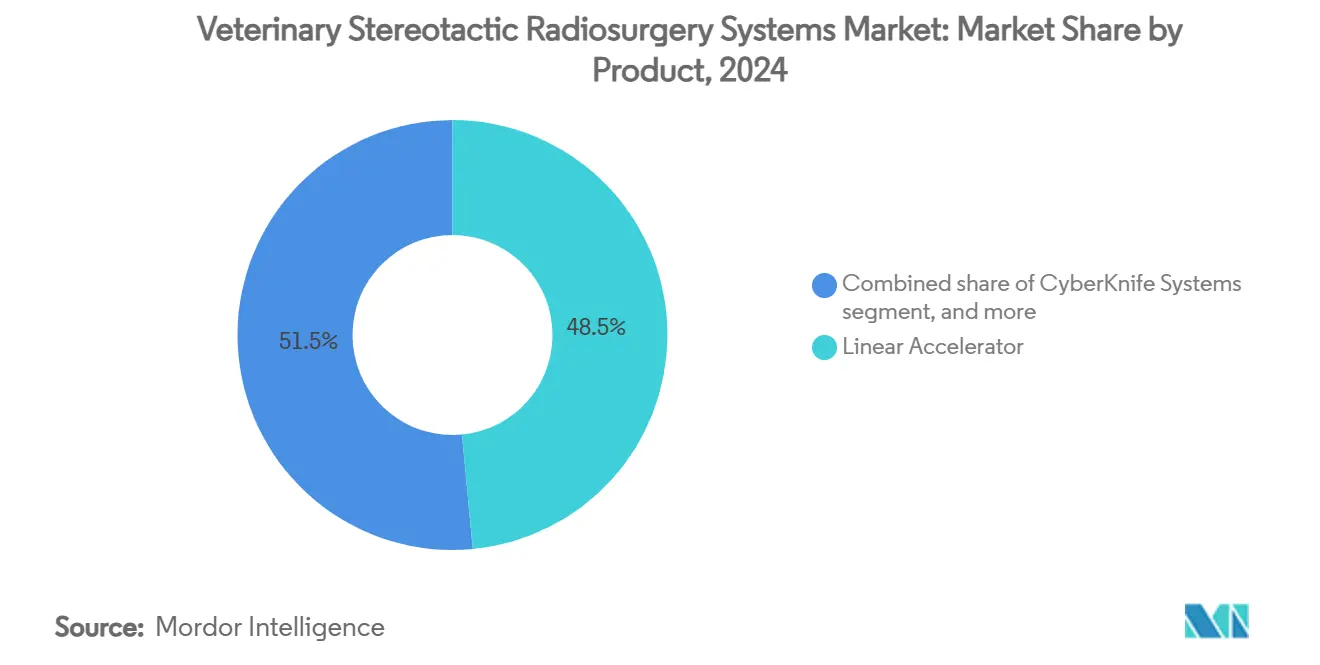
Note: Segment shares of all individual segments available upon report purchase
By Application: Brain Tumors Continue to Dominate
Brain lesions accounted for 41.45% of total case volume in 2024 as stereotactic radiosurgery offers non-invasive control where craniotomy carries prohibitive morbidity. Head-and-neck disease lines are rising at 13.54% CAGR, driven by improved immobilization techniques and dose-sculpting algorithms that protect adjacent critical structures. The Veterinary stereotactic radiosurgery systems market size attributed to spinal tumors is also increasing as motion-management tools mature.
Evidence demonstrates median canine survival exceeding two years following stereotactic treatment of intracranial tumors, far outperforming traditional fractionated protocols. Expanding indication sets broaden utilization, enhancing return on equipment investment and stabilizing workflow for treatment teams.
By End User: Hospitals Capture Majority Share
Hospitals delivered 52.56% of all procedures in 2024 as comprehensive oncology departments consolidate surgery, chemotherapy, and radiation under one roof. Research institutions, growing at 13.78% CAGR, secure grant funding to pioneer species-specific protocols, later disseminated to private practice. The Veterinary stereotactic radiosurgery systems market size for clinics with fewer than 10 oncology beds remains constrained by limited capital and staffing, reinforcing acquisition by corporate chains.
Academic partnerships with equipment vendors facilitate early-access studies, accelerating regulatory acceptance of new beam technologies. These collaborations position universities as reference centers, indirectly promoting manufacturer brand equity across the referral network.
By Animal Type: Companion-Animal Dominance with Equine Upside
Companion-animal cases represented 58.65% share in 2024, chiefly comprising geriatric dogs and cats with brain or nasal tumors. Equine demand, climbing at 12.99% CAGR, derives from the high economic value of performance horses and breeders’ willingness to invest in limb-sparing interventions. Colorado State University’s adaptation of stereotactic techniques for ferrets, birds, and other exotics highlights a broader diversification trend[2]CSU Animal Cancer Center, “Expanding Radiation Therapy to Exotic Species,” csuanimalcancercenter.org.
Species-specific immobilization hardware and tailored anesthesia protocols create incremental revenue streams for device manufacturers. As clinical evidence accumulates, insurers may extend coverage beyond dogs and cats, potentially unlocking new share for the Veterinary stereotactic radiosurgery systems market in niche animal segments.
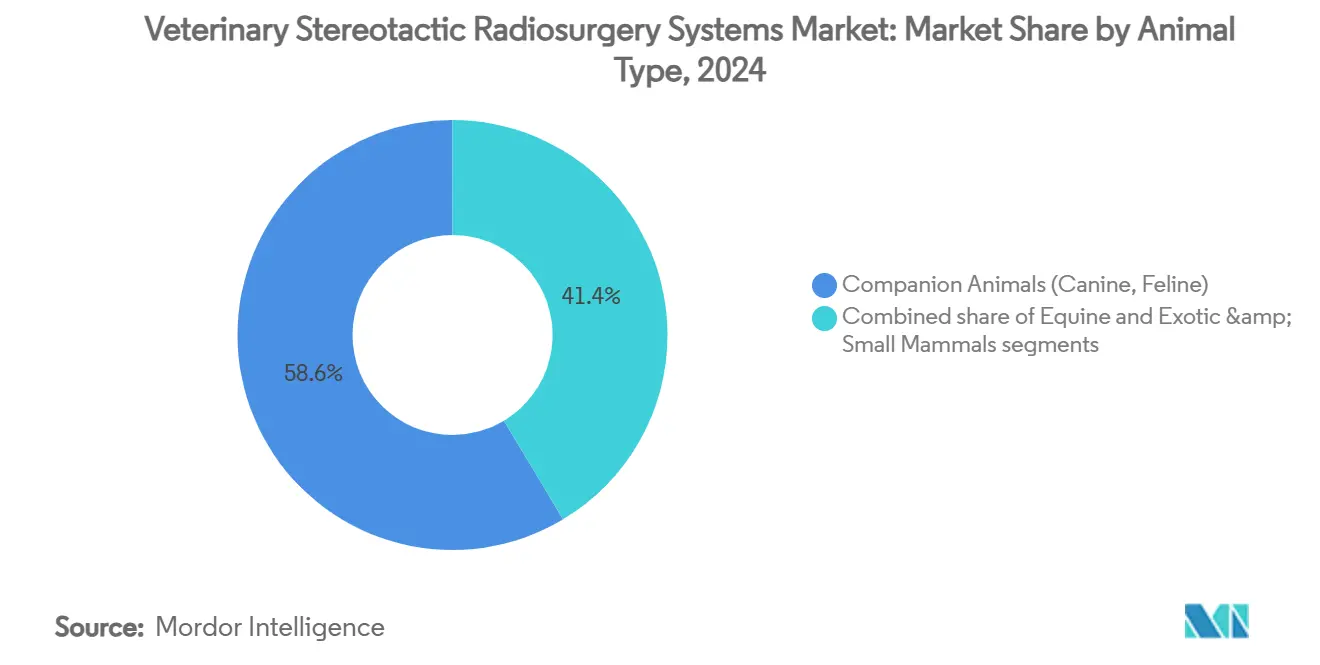
Note: Segment shares of all individual segments available upon report purchase
By Beam Technology: Photon Leads, Proton Advances
Photon platforms delivered 45.67% of treatments in 2024 thanks to entrenched clinical familiarity and lower operating costs. Proton and heavy-ion beams are advancing at 12.43% CAGR, favored for pediatric and ocular indications where dose-sparing is paramount. Veterinary trials reveal comparable local-control rates with reduced acute dermatitis relative to photon plans.
Compact proton units and modular shielding solutions reduce capital barriers, yet high maintenance outlays restrict diffusion to high-volume hubs. As price curves decline, several second-tier referral centers plan installations after 2027, signalling the next growth wave for the Veterinary stereotactic radiosurgery systems market.
Geography Analysis
North America retained a 38.76% revenue share in 2024, underpinned by mature insurance adoption and the presence of large multi-hospital networks able to amortize USD-multimillion equipment costs. Early adoption of technologies such as CyberKnife validates the clinical model and supplies training pipelines for new specialists. Market expansion remains steady as pet-owner awareness rises and early-screening tests feed higher case volumes.
Europe shows mid-single-digit growth buoyed by robust veterinary school infrastructure and harmonized device regulations. Facilities like Dick White Referrals invested GBP 15 million to triple capacity, integrating 0.35-T MRI simulators to streamline adaptive planning. Regional insurers cap out-of-pocket costs, further supporting uptake.
Asia–Pacific, posting 12.56% CAGR, benefits from rising disposable income and evolving regulations that now accept CE-marked radiotherapy systems with limited local testing, accelerating import pathways[3]Japan Ministry of Agriculture, Forestry and Fisheries, “Guidelines for Veterinary Medical Devices,” maff.go.jp. China’s urban middle class increasingly views advanced pet care as a lifestyle marker, yet specialist shortages remain acute. Joint-training programs with US and EU colleges are underway to build regional expertise.
South America, the Middle East, and Africa remain nascent markets where import duties and currency volatility hinder equipment procurement. Pilot installations in Mexico signal gradual improvement as governments prioritize companion-animal welfare, but widespread adoption awaits stronger insurance penetration and workforce development.
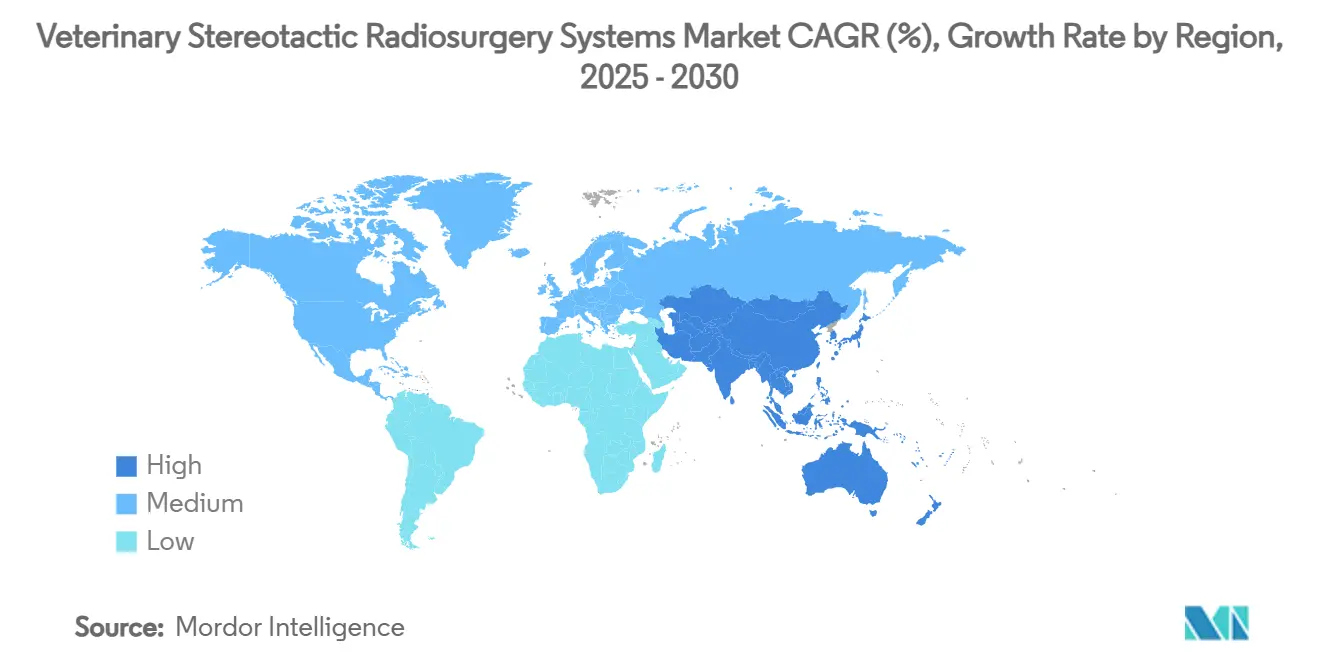
Competitive Landscape
Siemens Healthineers’ USD 16.4 billion acquisition of Varian in 2021 formed a vertically integrated powerhouse combining diagnostics, treatment planning, and therapy delivery under one corporate roof. Elekta competes through AI-enabled adaptive features and has won multi-site tenders in Mexico and India, demonstrating appeal in cost-sensitive settings. Accuray’s CyberKnife remains the reference platform for frameless intracranial cases but faces rising photon-linac sophistication that narrows its differentiation.
Disruptors leverage biology-guided or injectable solutions. RefleXion’s X1 received FDA clearance under the expanded-use pathway and is in pre-clinical veterinary trials for moving lung tumors. Vivos’ IsoPet radiogel, an injectable yttrium-90 hydrogel, offers tumor-conforming beta therapy that could reduce or replace external-beam sessions for certain indications.
Competitive pressure concentrates on software ecosystems, workflow automation, and post-sale service rather than brute hardware power. Manufacturers able to bundle cloud-based quality assurance and tele-oncology support stand to win a larger slice of the Veterinary stereotactic radiosurgery systems market.
Veterinary Stereotactic Radiosurgery Systems Industry Leaders
-
Accuray Inc.
-
Elekta AB
-
PetCure Oncology
-
Xstrahl Ltd.
-
Varian Medical Systems Inc.
- *Disclaimer: Major Players sorted in no particular order
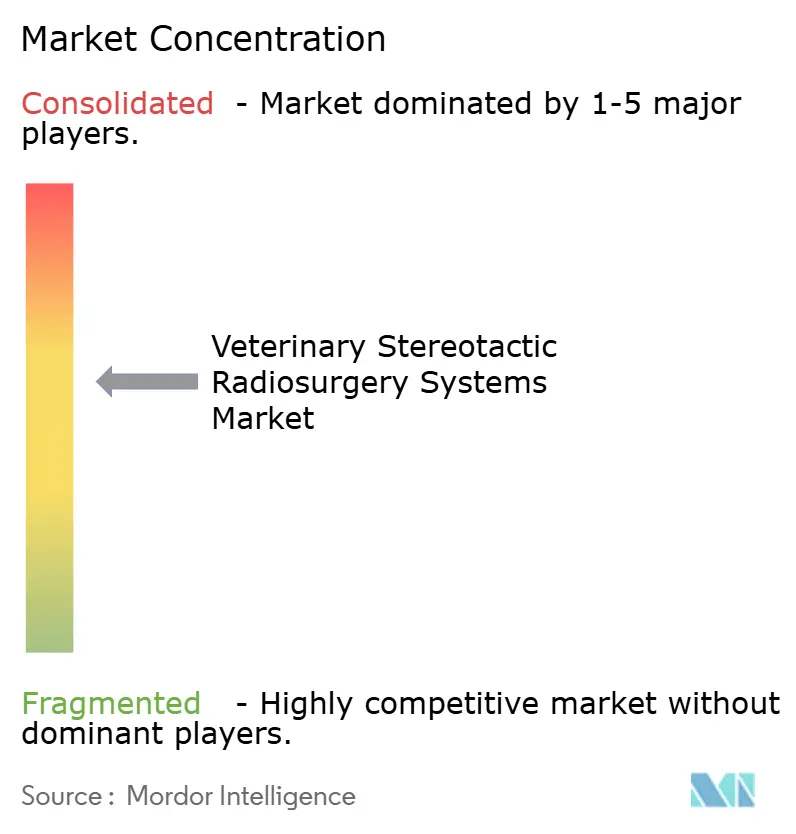
Recent Industry Developments
- March 2025: Siemens Healthineers unveiled the “New Ambition” phase of Strategy 2025, prioritizing AI-enhanced precision therapy with explicit veterinary oncology extensions.
- February 2025: Varian partnered with Sun Nuclear to integrate the SunCHECK QA platform, reinforcing safety compliance across small-animal radiotherapy suites.
- January 2025: IDEXX rolled out the Cancer Dx blood test at USD 15 per sample for early canine lymphoma detection, targeting 20 million at-risk dogs in North America.
- December 2024: PetCure Oncology published its 2025 outlook highlighting workflow digitalization and shorter treatment protocols in pet radiotherapy.
- October 2024: Elekta announced a breakthrough adaptive protocol for high-grade gliomas that integrates volumetric MRI data into real-time planning.
- September 2024: RefleXion completed the first multi-modality treatment plan that merged PET signaling with photon delivery, opening the door to biology-guided veterinary applications.
Global Veterinary Stereotactic Radiosurgery Systems Market Report Scope
As per the scope of the report, the veterinary stereotactic radiosurgery (SRS) systems market involves specialized medical devices used to treat animals with cancer or other abnormal growths through high-precision radiation therapy. These systems target tumors with focused radiation beams, minimizing damage to surrounding healthy tissue.
The veterinary stereotactic radiosurgery systems market is segmented by product, application, end user, and geography. The product segment is further divided into linear accelerator, cyber knife, and gamma knife. The application segment is further segmented into brain tumors, spinal tumors, and other applications. The end user segment is further divided into veterinary hospitals, veterinary specialty clinics, and research and academic institutions. The geography segment is further divided into North America, Europe, Asia-Pacific, Middle East and Africa, and South America. The market report also covers the estimated market sizes and trends for 17 different countries across major regions globally. The report offers the market sizes and forecasts in value (USD) for the above segments.
| Linear Accelerator Systems |
| CyberKnife Systems |
| Gamma Knife Systems |
| Proton / Heavy-ion Systems |
| Brain Tumours |
| Spinal Tumours |
| Head & Neck Tumours |
| Soft-Tissue / Other Tumours |
| Veterinary Hospitals (≥10 oncology beds) |
| Veterinary Specialty Clinics (<10 oncology beds) |
| Research & Academic Institutions |
| Companion Animals (Canine, Feline) |
| Equine |
| Exotic & Small Mammals |
| Photon Beam |
| Gamma Photon |
| Proton / Heavy-ion |
| North America | United States |
| Canada | |
| Mexico | |
| Europe | Germany |
| United Kingdom | |
| France | |
| Italy | |
| Spain | |
| Rest of Europe | |
| Asia-Pacific | China |
| Japan | |
| India | |
| Australia | |
| South Korea | |
| Rest of Asia-Pacific | |
| Middle East & Africa | GCC |
| South Africa | |
| Rest of Middle East & Africa | |
| South America | Brazil |
| Argentina | |
| Rest of South America |
| By Product | Linear Accelerator Systems | |
| CyberKnife Systems | ||
| Gamma Knife Systems | ||
| Proton / Heavy-ion Systems | ||
| By Application | Brain Tumours | |
| Spinal Tumours | ||
| Head & Neck Tumours | ||
| Soft-Tissue / Other Tumours | ||
| By End User | Veterinary Hospitals (≥10 oncology beds) | |
| Veterinary Specialty Clinics (<10 oncology beds) | ||
| Research & Academic Institutions | ||
| By Animal Type | Companion Animals (Canine, Feline) | |
| Equine | ||
| Exotic & Small Mammals | ||
| By Beam Technology | Photon Beam | |
| Gamma Photon | ||
| Proton / Heavy-ion | ||
| Geography | North America | United States |
| Canada | ||
| Mexico | ||
| Europe | Germany | |
| United Kingdom | ||
| France | ||
| Italy | ||
| Spain | ||
| Rest of Europe | ||
| Asia-Pacific | China | |
| Japan | ||
| India | ||
| Australia | ||
| South Korea | ||
| Rest of Asia-Pacific | ||
| Middle East & Africa | GCC | |
| South Africa | ||
| Rest of Middle East & Africa | ||
| South America | Brazil | |
| Argentina | ||
| Rest of South America | ||
Key Questions Answered in the Report
What was the global value of the Veterinary stereotactic radiosurgery systems market in 2025?
It reached USD 3.71 billion and is projected to climb to USD 6.41 billion by 2030 at an 11.53% CAGR.
Which product currently dominates hospital installations?
Linear accelerators held 48.54% share in 2024 thanks to multi-modality versatility and longstanding clinical familiarity.
Why are proton and heavy-ion systems gaining veterinary interest?
They offer superior dose conformality that spares healthy tissue, driving a 13.56% CAGR despite higher capital requirements.
How many credentialed veterinary radiation oncologists are practicing worldwide?
Fewer than 100 specialists are certified, making workforce shortage a key growth bottleneck.
Which region is expected to grow the fastest through 2030?
Asia-Pacific leads with a forecast 12.56% CAGR as pet ownership and disposable income surge.
How is pet insurance influencing treatment uptake?
Policies reimbursing up to 90% of oncology costs are broadening owner access to stereotactic radiosurgery.
Page last updated on:
